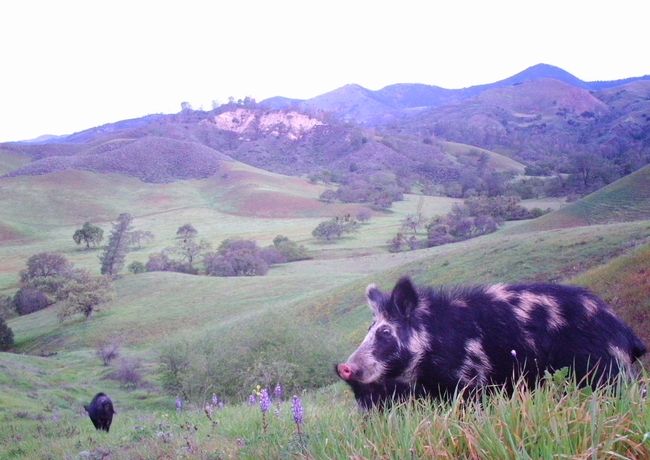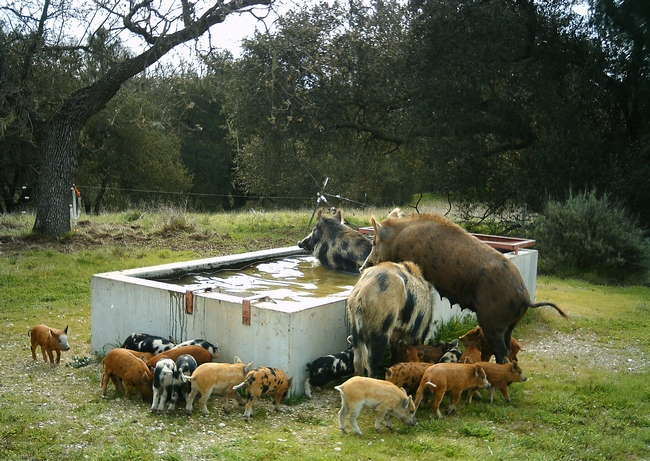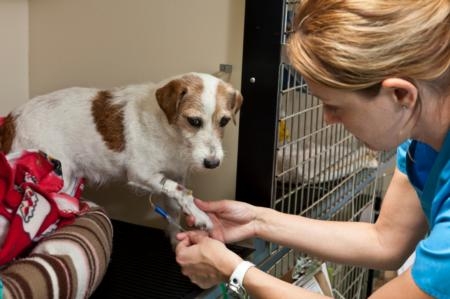Posts Tagged: Roger Baldwin
Got wild pigs? UC Cooperative Extension wants to hear from you
Wild pigs can spread disease to people, pets and livestock. Leptospirosis, tuberculosis and brucellosis are among more than 30 diseases that wild pigs can spread to humans and livestock. The feral pig species can damage forage and crops and contribute to erosion, which can affect water quality and allow invasive plant species to establish. The boorish boars can also prey on livestock, harassing, injuring or even killing cows, goats, sheep, horses and other animals.
Although anecdotal evidence of wild pig damage has been shared by landowners and farmers, official estimates of porcine damage occurring on agricultural lands are not well defined and are highly variable. To get a more accurate picture of the wild pig problem in California, UC Cooperative Extension is conducting a survey of landowners and ranchers statewide.
“The geographical extent of wild pig damage in California is currently unknown, making it difficult to mitigate and manage losses, and hard to estimate the economic impact on private landowners and public lands,” said John Harper, UC Cooperative Extension livestock and natural resources advisor in Mendocino and Lake counties.
To complement the survey, Harper and Roger Baldwin, UC Cooperative Extension wildlife specialist in the Department of Wildlife, Fish, and Conservation Biology at UC Davis, have developed a smartphone and mobile app that will help landowners and managers identify and record feral pig damage.
“Rangeland managers and farmers can enter data into the app from the field so that we can estimate the land area and economic impacts of feral pig damage over a longer time period,” said Baldwin. “Farmers and landowners who are interested in participating in data collection using our mobile application should fill out the survey and indicate their interest in the app at the end of the survey.”
To participate in the wild pig damage project, landowners and ranchers can fill out a short survey at http://ucanr.edu/wildpig2016.
The survey takes about 15 minutes to complete. Individual identities and survey responses will be kept confidential and participation in the survey is entirely voluntary.
Although wild pigs can be a nuisance in residential areas, this project is currently designed to assess the situation in rural settings.
For more information about the wild pig damage project or to obtain a paper copy of the survey, please contact Harper at (707) 463-4495 or jmharper@ucanr.edu or Baldwin at (530) 752-4551 or rabaldwin@ucdavis.edu.
Accidental dog poisoning on the rise
Veterinarians at the University of California, Davis, warn pet owners to be careful about using rat poisons and similar compounds.
In recent weeks, veterinarians at the UC Davis William R. Pritchard Veterinary Medical Teaching Hospital have seen a spike in accidental rodenticide poisonings. In the last two weeks of August alone, they diagnosed and treated six canine cases.
If not treated, a dog can die within a week of ingesting rodenticides.
"This is an all-too-common occurrence," said Karl Jandrey, assistant professor of clinical small animal emergency and intensive care at UC Davis. "People are trying to get rid of unwanted rodents, but are not realizing what these toxins do to the other animals who share that environment."
Keeping pets safe
Using proper pest control techniques can help keep family pets safe, said Roger Baldwin, UC Cooperative Extension advisor with the UC Integrated Pest Management Program. Baldwin, a wildlife pest management expert, is based at the UC Kearney Agricultural Research and Extension Center in Parlier.
Dogs can be affected by rodenticides two ways: by eating the poisoned bait or by eating an animal that was poisoned. Both can have serious consequences.
Home improvement stores like Lowes and Home Depot, and even grocery stores, carry a variety of products that may be used to control unwanted rats, mice, pocket gophers and ground squirrels. If the unwanted animals are inside the house, Baldwin recommends using traps rather than poison.
"If a poisoned animal dies behind a wall, you can't get it out and you have to live with the smell for weeks or months," Baldwin said.
Also, before baiting outdoor pests, Baldwin suggests making sure they are not also going inside buildings. If they are, find all potential access points and close them up.
If resorting to poison baits, buy a new product at the store and carefully read the label to understand when, where and how it can be used. Because of rapidly changing restrictions in recent years, old products in your garage or shed could be outdated.
Pocket gopher bait must be placed in the gopher's underground burrow. Even there, Baldwin said, certain dogs will dig up dead pocket gophers if they are close enough to the surface. Families with digging dogs will likely want to choose gopher traps. For ground squirrels, baits can be placed in bait stations or scattered very thinly on the ground through broadcast or spot treatments.
"When you use broadcast or spot treatments, there is relatively little danger to dogs or cats," Baldwin said. "But I would opt to use bait stations in my yard if I had pets running around, just to be on the safe side."
Some rodenticides contain ingredients that are anticoagulants, which slow the clotting of the blood. When dogs ingest these poisons, the active ingredients concentrate in the liver where they interfere with vitamin K storage and the production of blood clotting factors.
At UC Davis' veterinary teaching hospital, dealing with accidental poisoning by an anticoagulant rodenticide can require around-the-clock care with treatments in the intensive care unit to replenish blood clotting factors with fresh frozen plasma and replace vitamin K. If administered early enough, this treatment usually leads to a full recovery. Other rodenticides (e.g., bromethalin, cholecalciferol, strychnine and zinc phosphide) do not have antidotes, so treatment is more difficult.
One patient recently treated at UC Davis was Mocha, a one-year-old Belgian Malinois from Winters, Calif. Mocha had gotten into d-CON, a common rodenticide available at hardware stores.
Luckily, Mocha was brought to the veterinary teaching hospital in time. She responded well to treatment and was able to go home in two days.
"We are grateful for the care Mocha received at UC Davis," said Ken Shaw, Mocha's owner. "Like most dogs, Mocha is adventurous and likes to get into things she shouldn't. But after the treatment at UC Davis, she was home within a few days, happy and playful once again."



